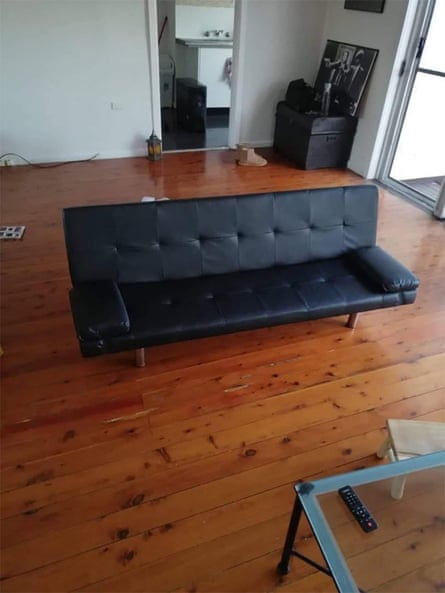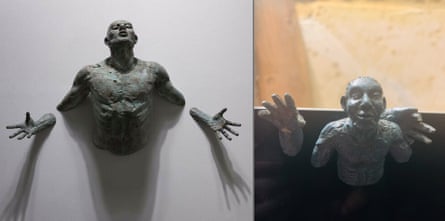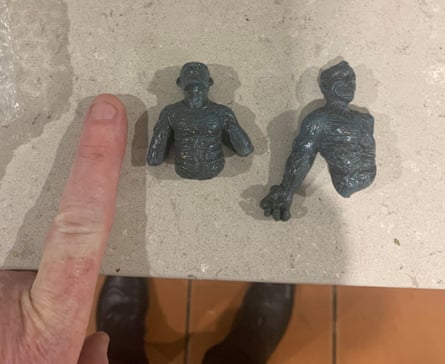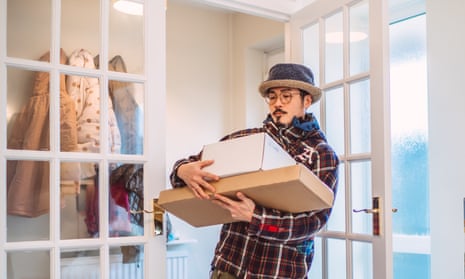When Sam Bowker and his partner moved into their new rental, they planned to buy a couch the same way they usually did – with a trip down to the local op-shop.
But Covid-19 scuppered this. The Salvation Army was no longer offering delivery services, so after a couple of drinks one evening, Bowker turned to eBay. There he found a “sleek-looking black three-seater lounge – it was a flatpack you build yourself, with free shipping”.
To Bowker, it looked like something out of a flash waiting room. It was a little more than he’d intended to spend, at $300, but it seemed worth it for something so nice. “So I ordered it, waited a week or two and the thing showed up in this tiny little box, sitting on the front doorstep.”

“My heart sank when I saw this tiny box,” he says. “Part of me was hoping it would build out bigger.”
It did not – the couch he’d acquired looked “like it had been hit with a shrink ray”. He went back to the listing and checked the measurements. The seat came out a mere 30cm (the standard depth for a lounge seat is between 55 and 70cm). “I’d say it’s for kids,” he guesses. “We didn’t send it back, we kept it in the lounge room. We sat on it and watched a movie once. One of the legs buckled in on it pretty soon after buying it. We ended up chucking it in the skip when we moved again.”
When he posted about the experience on Facebook, a few people chastised him for not checking the size before he bought it. “It feels really stupid admitting it – but you hear three-seater couch, you don’t think ‘what are the measurements’?”
Bowker is far from alone in experiencing online shopping mishaps during Covid lockdowns. I’ve fielded stories about errors in volume – six mandarins that became 6kg; the same pair of sneakers bought three times (“I gave one pair to my aunty … I couldn’t bear sending two back”); 12 bottles of tempranillo wine that turned out to be 12 cases (“A dangerous blessing in disguise,” the buyer quipped over Instagram).
Then there are the miscalculations of ambition (an abandoned ice-cream maker; a tough-to-use steam cleaner) or the thwarted hopes that normal life would resume sometime soon: a pair of nice high heels (“I didn’t wear heels before the pandemic, now I don’t even wear shoes”); a set of glittering false eyelashes (“When am I going to wear these? To Coles?”).
In a survey of 2,500 US consumers and 107 retailers, market research firm Incisiv found that online purchases were two to three times more likely to be returned than items bought in store.
With limited visual information, it can be hard to tell exactly what you’re buying when shopping online. With no staff to seek advice from, it is also easier for customers to make mistakes (buying nine loose shoe shelves for a frame they don’t fit into – that one was me); but mixups at the warehouses that store and distribute purchases are also common (a rubbish bin arrives with two separate lids, neither of which fit it – also me).
‘Bears zero resemblance to what was advertised’
But not all misadventures are innocent mistakes. When Chris Owen spotted some artwork advertised to him on Facebook as “antique sculptures” and “bronze”, he thought the pieces looked “creative and evocative”.
He paid $40, plus postage, for a sculpture. Then he waited. And waited. When he tried to contact the delivery company, only to discover they “did not seem to have any workable contact links”, he started to worry. “It took ages – well over three months … In the end I just left it then the package turned up.
“I checked my mailbox and in it were two boxes … sort of the size of a paperclip box. I thought this can’t be it? I opened it and it was and I just started laughing. This quickly turned to irritation.”

When his family got a look, “they couldn’t stop laughing at me. Still are,” he says.
Instead of the “cool” pieces advertised, he got a “poorly moulded tiny plastic piece of crap that bears zero resemblance to what was advertised. Even the scale is all wrong with the hands being twice the size of the head.
“I did check the details and knew it was resin but it was advertised as 15cm … didn’t think I was paying for bronze at that price, but nor did I think I was paying for a 3cm piece of moulded plastic.”

Owen tried pursuing a refund but the seller refused.
From January to the end of July this year, the Australian Competition and Consumer Commission received 10,873 reports of online shopping scams and more than $3.9m in losses. The ACCC say “these scams have been increasing since Covid began and we think it is partly due to lockdowns where people are unable to travel and/or examine the product in person.”
‘The greatest gift is regiving’

But not all lockdown shopping catastrophes have such bitter endings. When musician Jack Cowell was “at the pit of my lockdown despair”, he became obsessed with cottagecore, and one jewellery designer in particular: Beepy Bella. Although he had never been much of a jewellery wearer, Cowell “fell headfirst into the mystical world” of the designer, who makes “beautiful, ornate” necklaces out of irregular shaped pearls and toadstool, swan and raspberry charms, all modelled by “beautiful, elfish boys, girls and twinks”.
After agonising over the decision for a couple of weeks, “desperate for any serotonin or dopamine to hit my brain”, he decided to spend $500 on a necklace. “I knew that I would only be able to get one, it was my most expensive lockdown purchase.”
When the box arrived “it was amazing. It was covered in elf ears and mushrooms, beautiful gold leaf”. The necklace was housed in “almost a goblin money pouch”. Cowell “was immediately fascinated with this beautiful, beaded necklace”.
He pulled it carefully out of the pouch, placed it around his neck and just as he started admiring himself in the mirror, “the clasp literally popped off my neck and flew across the room”.
Since the necklace was broken, he could not return it. Noting that his “footballer’s neck” has been the subject of gentle teasing in the past, he says “having it snap was a confirmation that I can put off necklace wearing for another 10 years”.
“But then I have a beautiful friend called Megan, who was a bit down on their luck … and they embody everything about this brand, they could easily be cast as Arwen in Lord of the Rings.”
“So I decided that rather than being glum, the greatest gift is regiving. They got the clasp fixed and send me photos of the necklace regularly; they wear it almost every day.”
Have you had a pandemic shopping misadventure or regret? Share your story in the comments, which may be included in a follow-up feature

Comments (…)
Sign in or create your Guardian account to join the discussion